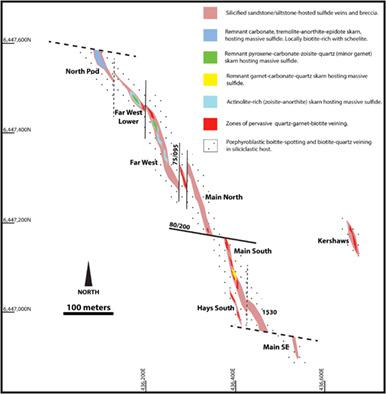The Hera orebody: A complex distal (Au–Zn–Pb–Ag–Cu) skarn in the Cobar Basin of central New South Wales, Australia
IF 0.8
4区 地球科学
Q3 GEOLOGY
引用次数: 5
Abstract
The Hera Au–Pb–Zn–Ag deposit in the southeastern Cobar Basin of central New South Wales preserves calc‐silicate veins and remnant sandstone/carbonate‐hosted skarn within a reduced anchizonal Siluro‐Devonian turbidite sequence. The skarn orebody distribution is controlled by a long‐lived, basin margin fault system, that has intersected a sedimentary horizon dominated by siliciclastic turbidite, with lesser gritstone and thick sandstone intervals, and rare carbonate‐bearing stratigraphy. Foliation (S1) envelopes the orebody and is crosscut by a series of late‐stage east–west and north–south trending faults. Skarn at Hera displays mineralogical zonation along strike, from southern spessartine–grossular–biotite–actinolite‐rich associations, to central diopside‐rich–zoisite–actinolite/tremolite–grossular‐bearing associations, through to the northern most tremolite–anorthite‐rich (garnet‐absent) association in remnant carbonate‐bearing lithologies and sandstone horizons; the northern lodes also display zonation down dip to garnet present associations. High‐T, prograde skarn assemblages rich in pyroxene and garnet are pervasively replaced by actinolite/tremolite–biotite‐rich retrograde skarn which coincides with the main pulse of sulfide mineralization. The dominant sulfides are high‐Fe–Mn sphalerite–galena–non‐magnetic high‐Fe pyrrhotite–chalcopyrite; pyrite, arsenopyrite; scheelite (low Mo) is locally abundant. The distribution of metals in part mimics the changing gangue mineralogy, with Au concentrated in the southern and lower northern lode systems and broadly inverse concentrations for Ag–Pb–Zn. Stable isotope data (O–H–S) from skarn amphiboles and associated sulfides are consistent with magmatic (or metamorphic) water and sulfur input during the retrograde skarn phase, while hydrosilicates and sulfides from the wall rocks display comparatively elevated δD and mixed δ34S consistent with progressive mixing or dilution of original magmatic (or metamorphic) waters within the Hera deposit by unexchanged waters typical of low latitude (tropical) meteoritic waters. High precision titanite (U–Pb) and biotite (Ar–Ar) geochronology reveals a manifold orebody commencing with high‐T skarn and retrograde Pb–Zn‐rich skarn formation at ≥403 Ma, Au–low‐Fe sphalerite mineralization at 403.4 ± 1.1 Ma, foliation development remobilization or new mineralization at 390 ± 0.2 Ma followed by thrusting, orebody dismemberment at 384.8 ± 1.1 Ma and remobilization or new mineralization at 381.0 ± 2.2 Ma. The polymetallic nature of the Hera orebody is a result of multiple mineralization events during extension and compression and involving both magmatic and likely formational metal sources.

Hera矿体:位于澳大利亚新南威尔士州中部Cobar盆地的一个复杂远端(Au-Zn-Pb-Ag-Cu)夕卡岩
位于新南威尔士州中部Cobar盆地东南部的Hera Au-Pb-Zn-Ag矿床保存着硅钙岩脉和残余砂岩/碳酸盐岩含矿矽卡岩,处于一个还原的志留纪-泥盆纪浊积层序中。矽卡岩矿体的分布受一个长期存在的盆地边缘断裂系统控制,该断裂系统与沉积层相交,沉积层以硅屑浊积岩为主,砾岩和厚砂岩层段较少,含碳酸盐地层较少。片理(S1)包裹着矿体,并被一系列晚期东西向和南北向断裂横切。赫拉的矽卡岩沿走向显示出矿物学分带,从南部的辉花石-粗榴石-黑云母-放光石组合,到中部的透辉石-富辉石-含放光石/透闪石-含粗榴石组合,一直到北部的残余含碳酸盐岩性和砂岩层中最富透闪石-富钙长石(不含石榴石)组合;北部的矿脉也显示出分带状,向下倾呈石榴石状组合。富含辉石和石榴石的高T -顺行矽卡岩组合普遍被富含放光石/透闪石-黑云母的逆行矽卡岩所取代,这与硫化物成矿的主脉冲相吻合。主要硫化物为高铁锰闪锌矿—方铅矿—非磁性高铁磁黄铁矿—黄铜矿;黄铁矿、毒砂;白钨矿(低钼)在当地丰富。金属的分布部分模仿脉石矿物学的变化,金富集于南部和北部下脉系统,银、铅锌的富集大致相反。矽卡岩角闪岩及其伴生硫化物的稳定同位素数据(O-H-S)与矽卡岩逆行期岩浆(或变质)水和硫的输入相一致,而来自围岩的氢硅酸盐和硫化物显示出相对较高的δD和混合δ34S,与Hera矿床内原始岩浆(或变质)水被典型的低纬度(热带)陨石水的未交换水逐渐混合或稀释相一致。高精度钛矿(U-Pb)和黑云母(Ar-Ar)年代学揭示了一个以高T矽卡岩和逆行富铅锌矽卡岩形成(≥403 Ma)为起点的多方位矿体,403.4±1.1 Ma为低金-铁闪锌矿成矿,390±0.2 Ma为片理发育再活化或新成矿,然后是逆冲作用,384.8±1.1 Ma为矿体解体,381.0±2.2 Ma为再活化或新成矿。Hera矿体的多金属性质是在伸展和挤压过程中多次成矿事件的结果,涉及岩浆和可能的地层金属来源。
本文章由计算机程序翻译,如有差异,请以英文原文为准。
求助全文
约1分钟内获得全文
求助全文
来源期刊

Resource Geology
地学-地质学
CiteScore
2.30
自引率
14.30%
发文量
18
审稿时长
12 months
期刊介绍:
Resource Geology is an international journal focusing on economic geology, geochemistry and environmental geology. Its purpose is to contribute to the promotion of earth sciences related to metallic and non-metallic mineral deposits mainly in Asia, Oceania and the Circum-Pacific region, although other parts of the world are also considered.
Launched in 1998 by the Society for Resource Geology, the journal is published quarterly in English, making it more accessible to the international geological community. The journal publishes high quality papers of interest to those engaged in research and exploration of mineral deposits.
 求助内容:
求助内容: 应助结果提醒方式:
应助结果提醒方式:


